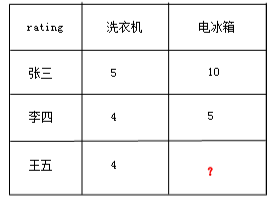基于C#实现协同推荐 SlopeOne 算法
一、概念
相信大家对如下的 Category 都很熟悉,很多网站都有类似如下的功能,“商品推荐”,"猜你喜欢“,在实体店中我们有导购来为我们服务,在网络上我们需要同样的一种替代物,如果简简单单的在数据库里面去捞,去比较,几乎是完成不了的,这时我们就需要一种协同推荐算法,来高效的推荐浏览者喜欢的商品。


SlopeOne 的思想很简单,就是用均值化的思想来掩盖个体的打分差异,举个例子说明一下:

在这个图中,系统该如何计算“王五“对”电冰箱“的打分值呢?刚才我们也说了,slopeone 是采用均值化的思想,也就是:R 王五 =4-{[(5-10)+(4-5)]/2}=7 。
下面我们看看多于两项的商品,如何计算打分值。
rb = (n * (ra - R(A->B)) + m * (rc - R(C->B)))/(m+n)
注意: a,b,c 代表“商品”。
ra 代表“商品的打分值”。
ra->b 代表“A组到B组的平均差(均值化)”。
m,n 代表人数。

根据公式,我们来算一下。
r 王五 = (2 * (4 - R(洗衣机-> 彩电)) + 2 * (10 - R(电冰箱-> 彩电))+ 2 * (5 - R(空调-> 彩电)))/(2+2+2)=6.8
是的,slopeOne 就是这么简单,实战效果非常不错。
二、实现
1、定义一个评分类 Rating。
/// 2、定义一个产品类
/// 3、SlopeOne 类
参考了网络上的例子,将二维矩阵做成线性表,有效的降低了空间复杂度。

using System;
using System.Collections.Generic;
using System.Linq;
using System.Text;
namespace SupportCenter.Test
{
#region Slope One 算法
/// 4、测试类 Program
这里我们灌入了 userid=1000,2000,3000 的这三个人,然后我们预测 userID=3000 这个人对 “彩电” 的打分会是多少?
public class Program
{
static void Main(string[] args)
{
SlopeOne test = new SlopeOne();
Dictionary<int, List<Product>> userRating = new Dictionary<int, List<Product>>();
//第一位用户
List<Product> list = new List<Product>()
{
new Product(){ ProductID=1, ProductName="洗衣机",Score=5},
new Product(){ ProductID=2, ProductName="电冰箱", Score=10},
new Product(){ ProductID=3, ProductName="彩电", Score=10},
new Product(){ ProductID=4, ProductName="空调", Score=5},
};
userRating.Add(1000, list);
test.AddUserRatings(userRating);
userRating.Clear();
userRating.Add(1000, list);
test.AddUserRatings(userRating);
//第二位用户
list = new List<Product>()
{
new Product(){ ProductID=1, ProductName="洗衣机",Score=4},
new Product(){ ProductID=2, ProductName="电冰箱", Score=5},
new Product(){ ProductID=3, ProductName="彩电", Score=4},
new Product(){ ProductID=4, ProductName="空调", Score=10},
};
userRating.Clear();
userRating.Add(2000, list);
test.AddUserRatings(userRating);
//第三位用户
list = new List<Product>()
{
new Product(){ ProductID=1, ProductName="洗衣机", Score=4},
new Product(){ ProductID=2, ProductName="电冰箱", Score=10},
new Product(){ ProductID=4, ProductName="空调", Score=5},
};
userRating.Clear();
userRating.Add(3000, list);
test.AddUserRatings(userRating);
//那么我们预测userID=3000这个人对 “彩电” 的打分会是多少?
var userID = userRating.Keys.FirstOrDefault();
var result = userRating[userID];
var predictions = test.Predict(result);
foreach (var rating in predictions)
Console.WriteLine("ProductID= " + rating.Key + " Rating: " + rating.Value);
}
}
